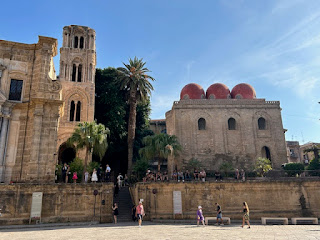SICILY 2023
Palermo
We were to spend just over two weeks on the island of Sicily, a trip full of discoveries whilst travelling from West to East in an anti-clockwise direction.
We started by exploring Palermo, a fascinating city with winding streets that took us to its historic sights, notably the glistening golden mosaics of the Palatine Chapel of the Norman Palace. I was mesmerised by the biblical images adorning the walls and dome. I found it to be as impressive as the Sistine Chapel in Rome, yet far less crowded allowing us to spend time in awe of these intricate works of art.
We
were staying in the trendy district La Kalsa, in an apartment whose roof
terraces and interior design merited the steep climb up the narrow staircase of
a tall building. This bright and spacious apartment had been tastefully
renovated by its elegant owner Valentina who happened to be an architect. She
kindly invited us to her office in the white-washed vaults of an ancient palace
– an inspiring place to work.
When exploring this ancient city we kept crossing the Baroque Quattro Canti, or Four Corners, considered to be the centre of the historic quarter. Officially known as Piazza Vigliena, this octagonal is divided into four streets and four symmetric facades, each of the latter features a fountain dedicated to one of the four seasons, topped by a statue of a Spanish ruler then a female patron saint of Palermo.
We were keen to sample the brioche and granita, a local breakfast choice that we enjoyed with a rich espresso at a reputable café, Casa Stagnitta, recommended once again by Valentina. The granita is a Sicilian speciality, similar to sorbet but the combination of fruit or nuts, water and sugar is constantly stirred to obtain tiny ice crystals, resulting in a grainy yet creamy consistency. Popular flavours are lemon and almond; we chose the latter whose splinters of almonds indicated that it was indeed homemade as the café claimed.
In sharp contrast to the elaborate religious murals and mosaics of Palermo’s churches was the selection of works in its modern art museum. This diverse collection ranged from sacks of multi-coloured paint, angular sculptures to an inverted tree whose roots represented its branches.
Cefalu & Monreale
Before our next destination, Trapani, we made a slight diversion in the opposite direction to visit the much-acclaimed seaside town of Cefalu, where we found a multitude of rainbow-coloured parasols covering its crowded beach. Living on a Caribbean island where isolated beaches are aplenty, we preferred to simply tour this picturesque town. We made our way through its narrow streets lined with tall mustard-coloured houses adorned with wrought iron balconies, some draped with laundry while others were garnished with geraniums. These thoroughfares opened out onto Cefalu’s large cathedral square, where we found a host of lively cafés in the midst of lunchtime. This midday hour also meant that the cathedral was closed, somewhat disappointing but some things are just not meant to be.
We were soon consoled by the spectacular mosaics in Monreale cathedral, whose vast interior is covered in religious scenes depicting both the old and new testament. Spanning 6,500 square metres, these are said to be Italy’s most extensive mosaic decoration, surpassing San Marco in Venice.

















